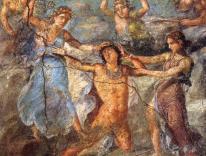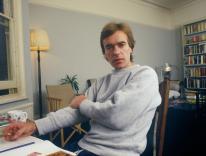
Zadie Smith introduces her 2018 essay collection, Feel Free, with this remarkable note:
I realize my somewhat ambivalent view of human selves is wholly out of fashion. These essays you have in your hands were written...during the eight years of the Obama presidency and so are the product of a bygone world. It is of course hardly possible to retain any feelings of ambivalence—on either side of the Atlantic—in the face of what we now confront. Millions of more or less amorphous selves will now necessarily find themselves solidifying into protesters, activists, marchers, voters, firebrands, impeachers, lobbyists, soldiers, champions, defenders, historians, experts, critics. You can’t fight fire with air. But equally you can’t fight for a freedom you’ve forgotten how to identify.
For Smith, a self can never be fully summed up or pinned down. In the best of times, it shouldn’t need to “solidify” into anything. No collective tag, no personal description, not even an authorized biography, can totally cordon off what someone is from what she is not. To discover yourself is to become aware that you are a being “whose boundaries are uncertain, whose language is never pure, whose world is in no way ‘self-evident.’” Every human being finds her origin in others—other people, other tongues, other eras. To be free is to recognize this state of affairs and respond creatively. The artist is therefore something close to the paradigm of the free self.
If this view of being human seems hopelessly abstract, Feel Free helpfully provides many examples of it. Smith often writes about artists who are bold, scandalous, and meet resistance from critics and the public. A free self (Jay-Z) plays with language, stretching it to the limit (“The House That Hova Built”). A free self may rebel against his roots (Philip Roth in “The I Who Is Not Me”), rebel against what others think of him (“Meet Justin Bieber!”), or enjoy being just plain weird (“Crash by J. G. Ballard”). Smith also talks about herself in these terms. She laments the divides of class and culture that still plague Britain, exploited by politicians and making diverse friendships difficult (“Fences: A Brexit Diary”). In a 2019 essay titled “Fascinated to Presume: In Defense of Fiction,” the acclaimed author of novels like White Teeth (2000) and On Beauty (2005) describes herself as someone who has “never believed myself to have a voice entirely separate from the many voices I hear, read, and internalize every day.”
But what happens when the walls start closing in? If, as Smith concedes, Brexit and the presidency of Donald Trump threw us into a situation that made her philosophy of selfhood seem like an outdated luxury, what about the pandemic? It too imposes new demands upon the free self. The moment we are currently living through reveals “the complex and ambivalent nature of ‘submission,’” Smith says in Intimations, a new collection of essays written during the months of lockdown.
Like most of us, Smith has often felt trapped during this time. But the ambivalent nature of submission means one may discover inner liberation even while being subject to a stay-at-home order. It follows that being free is not the same thing as being unencumbered. Smith began learning these lessons shortly before the lockdown began, while admiring tulips through the bars of the wrought-iron fence of a Manhattan public garden. During a brief respite from her busy schedule, she sees “not a very sophisticated flower—a child could draw it—and these were garish: pink with orange highlights.” Smith becomes transfixed, “my fingers curled around those iron bars.” The “vulgar” flowers somehow command stillness on her part. They intrude upon her day. Soon enough, the lockdown would also command stillness and intrude upon her days for months. But Smith did not submit to the tulips: “Even as I was peering in at them, I wished they were peonies.” Does rebelling in this way enhance one’s freedom? If the world offers us a simple beauty, even a mediocre one, do we gain anything from rejecting the gift? Is true freedom more like the easy contemplation of a flower, or the radical creativity of the artist?
An answer might be found in the essay titled “Something to Do.” “Now there are essential workers—who do not need to seek out something to do; whose task is vital and unrelenting—and there are the rest of us, all with a certain amount of time on our hands.” This free time might seem ideal for a writer, if in fact the artist is the paragon of freedom. But Smith struggles like everybody else. “Confronted with the problem of life served neat, without distraction or adornment or superstructure, I had almost no idea of what to do with it.” Art is “something to do,” but it does not fill the void more meaningfully than any other activity. Quite the contrary: it makes us aware of how unnecessary many of our activities really are.
Smith concludes that writing—and everything else—becomes worthwhile only if it is done out of love “in the Platonic sense,” that is, “an ideal form and essential part of the universe—like ‘Beauty’ or the color red—from which all particular examples on earth take their nature.” That’s not quite right: love is not an ideal form for Plato, but rather the force of desire that drives us toward ideal forms (like Beauty) and opens us to friendship, marriage, and solidarity. But her point is well taken. Art is worthwhile when it is done for the sake of love, because love draws us out of ourselves, toward the world, toward others—toward tulips, even during a pandemic.
There’s a lot of political commentary in Intimations, as there should be. While inner freedom is perhaps freedom in its highest form, it is also the case that the system one lives under and the people who run it greatly influence what one can do and who one can become. Smith’s views are at least partially founded in the existentialist tradition, and she would probably agree with Simone de Beauvoir’s description of the human condition in The Ethics of Ambiguity: “He asserts himself as a pure internality against which no external power can take hold, and he also experiences himself as a thing crushed by the dark weight of other things.” Politics can confront many of those “other things.” Smith’s own political temperament gravitates toward the center-left. In Feel Free, she expresses gratitude for the beneficent postwar British welfare state. Concerning the neoliberal dismantling of it, she quotes the English social democrat Tony Judt approvingly: “We need to learn to think the state again.”
In Intimations, Smith’s own rethinking of the state considers the institutions that make freedom possible. In “The American Exception,” she meditates on the use of war as a metaphor for the pandemic, then considers how this makes clear the importance of state-provided health care: “War transforms its participants.... What was taken for granted, underappreciated and abused now reveals itself to be central to our existence.... People find themselves applauding a national health service that their own government criminally underfunded and neglected these past ten years.” In “A Hovering Young Man,” she laments the modern rejection of the “mundane realities” of the welfare state (“universal health care, free university education, and decent public housing”). “It is easy to despise institutions, to feel irritated or constrained by them,” she writes. But then she contemplates the life of an artistic and eccentric coworker at NYU, a somewhat fragile soul: “I felt glad he was at least tethered to an institution, like a red balloon caught in a tree, instead of floating out into the unforgiving city,” all the more unforgiving during the lockdown. I see what she means, though this last thought gave me pause: the artist must go out into the unforgiving city and report unflinchingly about what goes on in it.
Smith’s sharpest political essay is “Contempt as a Virus,” which deals with racism and was written after the killing of George Floyd. Racism is a species of contempt, and contempt—a “virus” in Smith’s pandemic-inspired metaphor—is a mode of seeing human beings that reduces them to subhuman status:
Patient zero of this particular virus stood on a slave ship four hundred years ago, looked down at the sweating, bleeding, moaning mass below deck and reverse-engineered an emotion—contempt—from a situation that he, the patient himself, had created. He looked at the human beings he had chained up and noted that they seemed to be the type of people who wore chains.... And having thus placed them in a category similar to the one in which we place animals, he experienced the same fear and contempt we have for animals.
The enslaver is simultaneously objectifying the slave, categorizing her under a fixed essence that is a prison (“people who like to be in chains”) and failing to see what is truly essential about her: her dignity, her freedom, her right to life. The three building blocks of the enslaver’s contempt are “They have no capital, not even labor. Anything can be done to them. They have no recourse.” These viral strands have been passed on through “churches and schools, adverts and movies, books and political parties,” to this very day. “Many people are unaware that they carry the virus at all until the very moment you find yourself phoning the cops.”
Smith sees the economic dimension as the most important aspect of the problem: the racist “mentality looks over the fence and sees a plague people: plagued by poverty, first and foremost.” The fear of “contracting” poverty drives racial division. “To fear the contagion of poverty is reasonable,” she writes. “To keep voting for politics that ensure the permanent existence of an underclass is what is meant by ‘structural racism.’” Smith calls for “all economically exploited people, whatever their race—[to] act in solidarity with each other,” because “real change would involve a broad recognition that...the DNA of this virus is economic at base.” But she is not hopeful about this change taking place.
There is an activist side to Zadie Smith that is marching in the streets. There is another, bohemian, side to her that might not mind lounging around with the Rolling Stones at Villa Nellcôte. The former exists so that the latter might be free: Freedom is what Smith is ultimately about, and her political critique is made at the service of this overarching ideal. Described in this way, Smith comes off as a sort of John Stuart Mill–style liberal, who defends egalitarianism in the political sphere and the right to “experiments in living” for individuals.
But there is a third, less pronounced element to Smith’s essays that knits together all of her thoughts, judgments, and intimations: love. Love is what makes freedom meaningful, what gives the ever-shifting self a certain mission in life. Love is what compels us to accept the simple gift of a flower, and the rights and dignity of our neighbor. As she put it in an interview last year: “I think the hardest thing for anyone is accepting that other people are real as you are. That’s it. Not using them as tools not using them as examples or things to make yourself feel better or things to get over or under.... And it’s so difficult that basically the only person that ever did it was Christ.” This last could be called the spiritual side of Zadie Smith. It is what completes her: an honest, searching conscience in difficult times.
Intimations
Six Essays
Zadie Smith
Penguin Books
$10.95 | 112 pp.
Please email comments to [email protected] and join the conversation on our Facebook page.
Previous Story
Only a Down Payment
Next Story
Biden the Catholic


